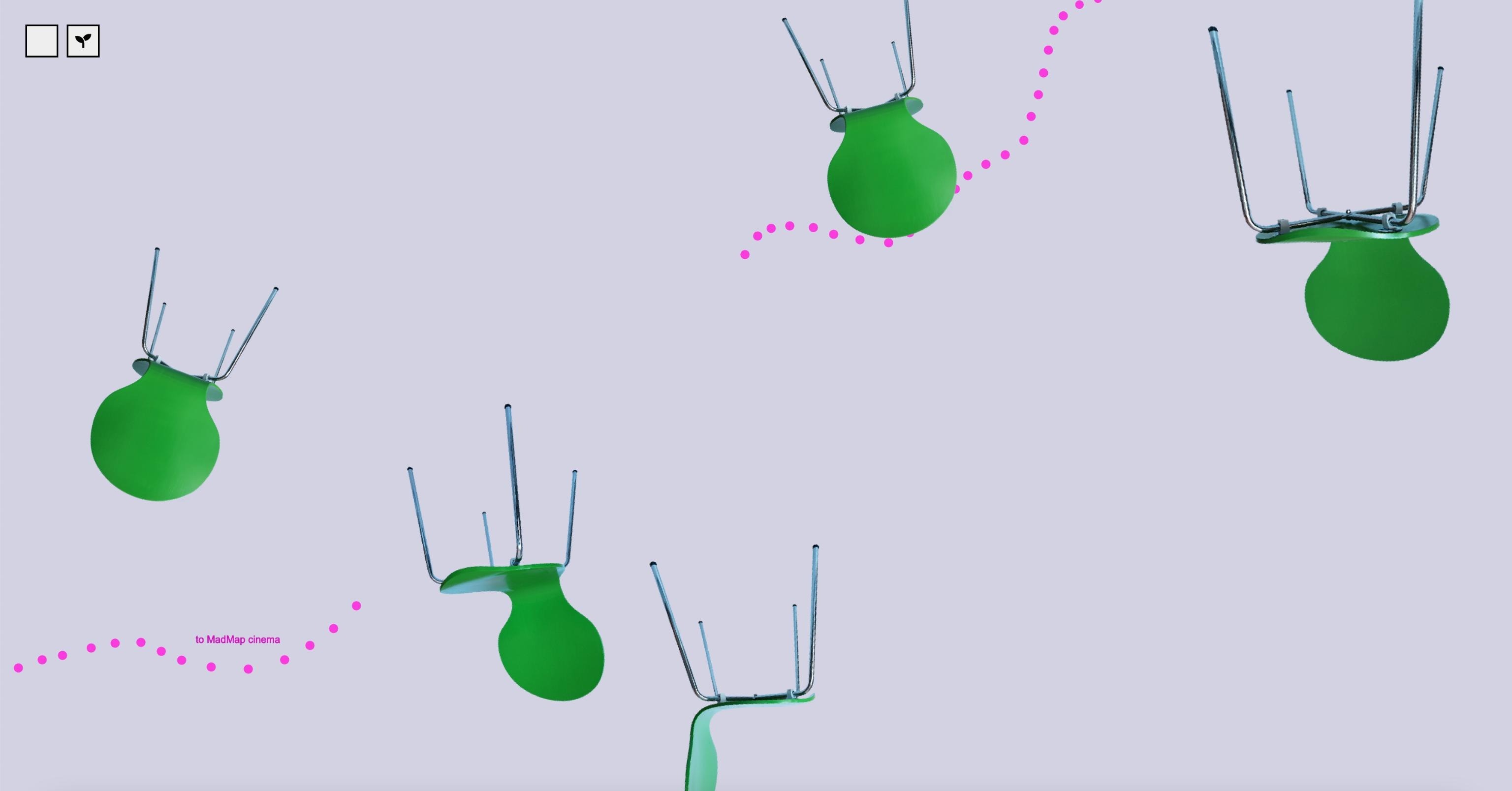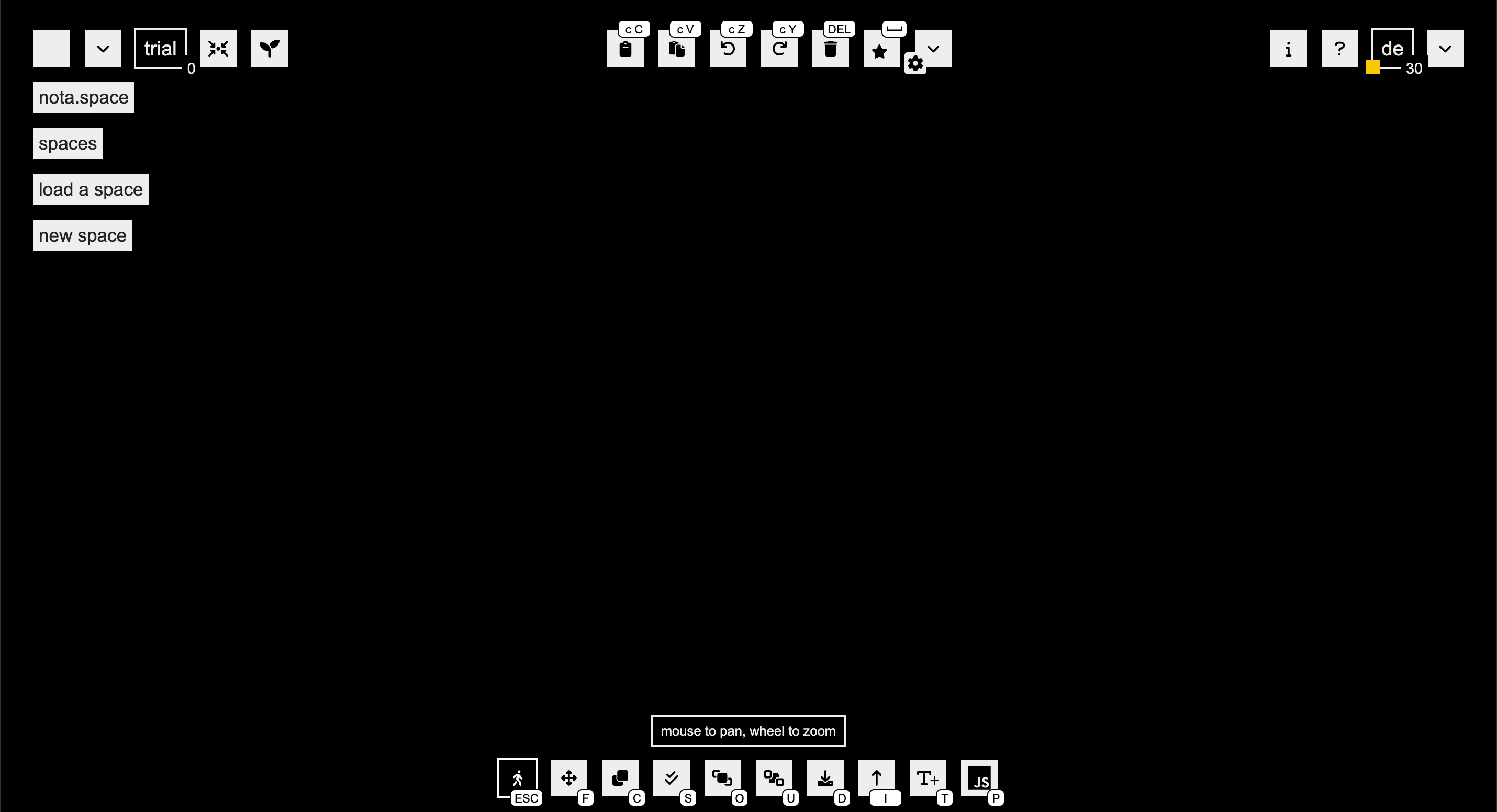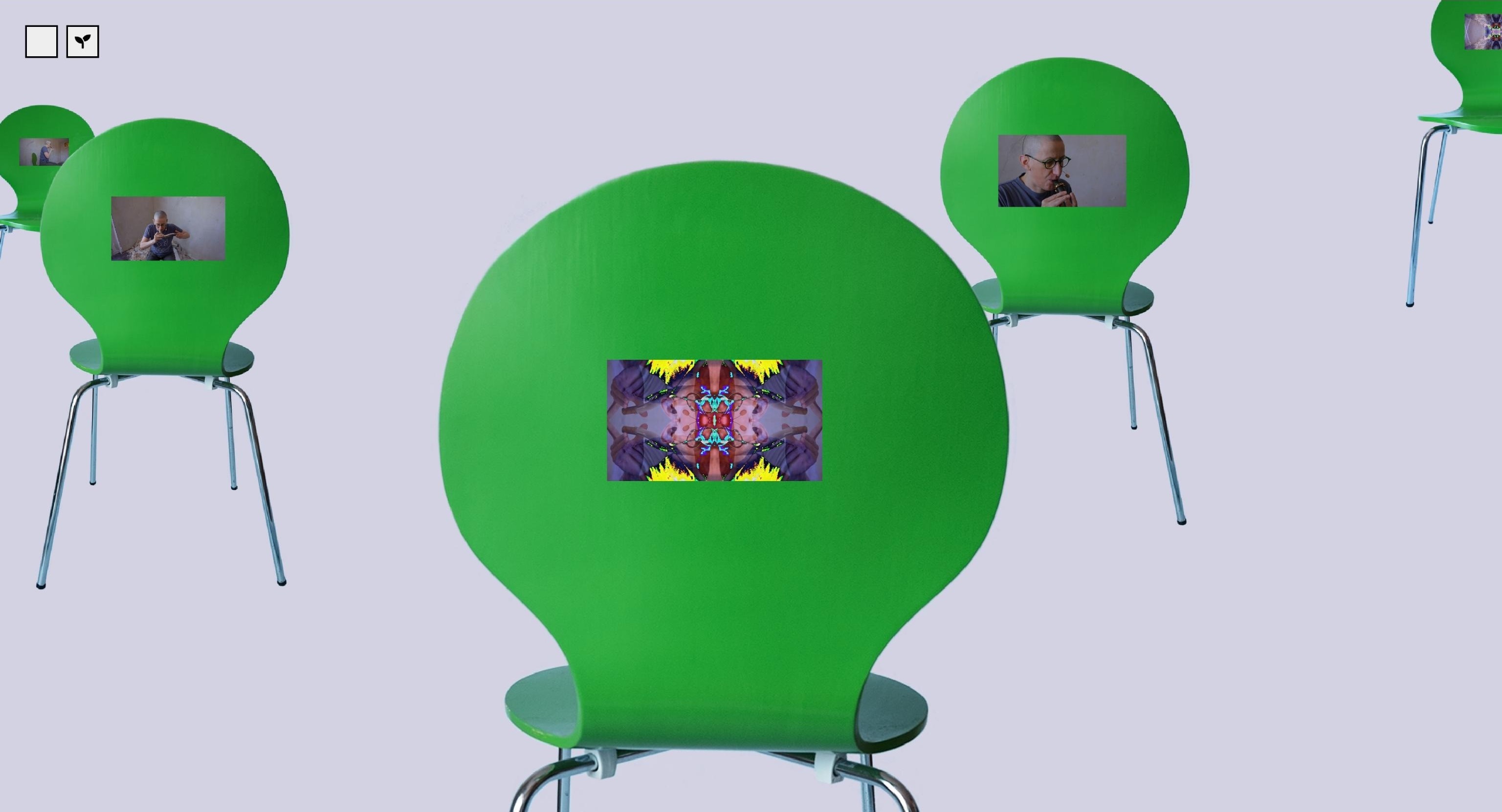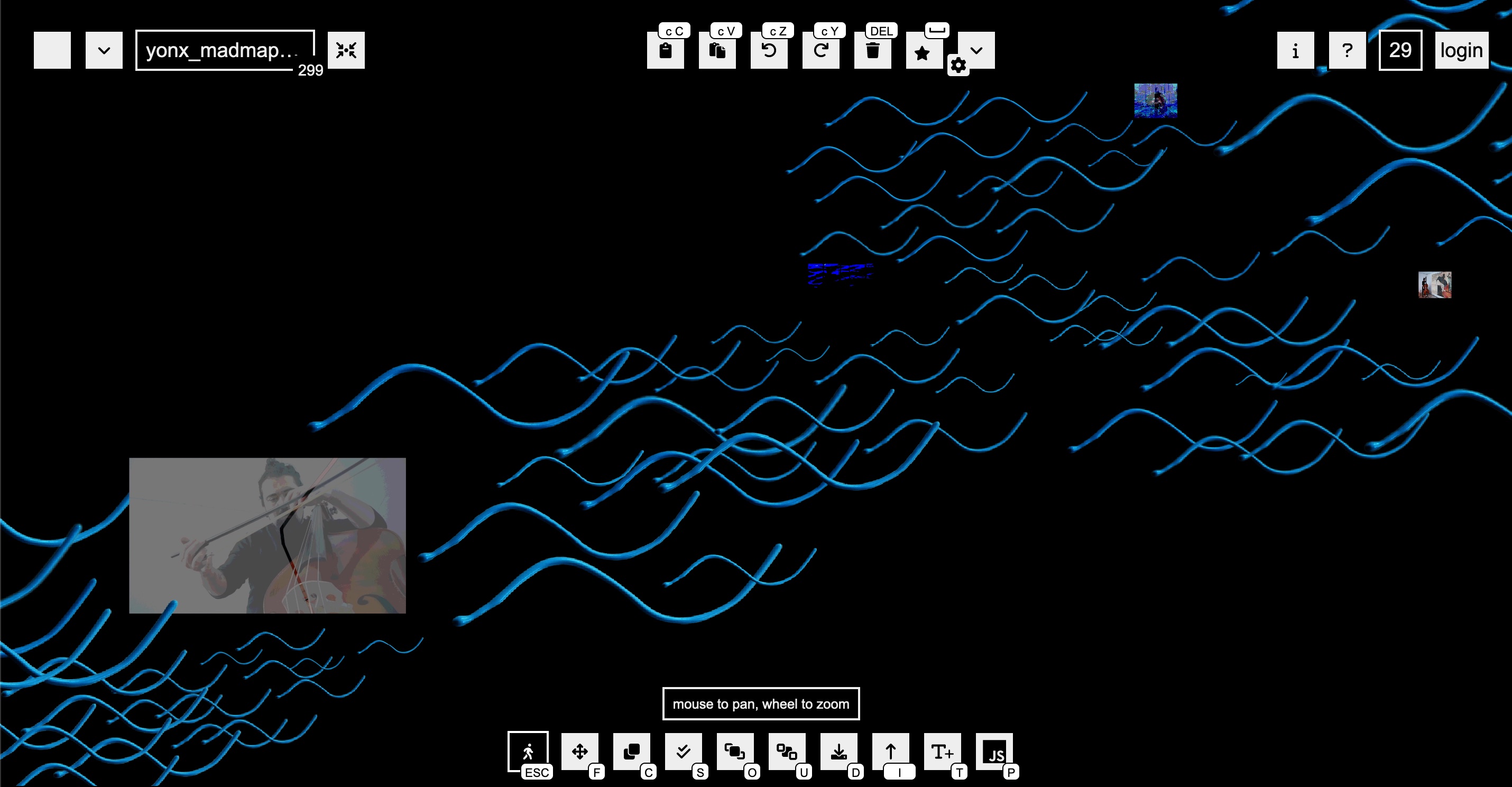
Whole milk, mad maps and digital bees: Nikola Lutz on nota and web-based sound art
For this first interview about WebSoundArt, I spoke with Nikola Lutz about the
multidisciplinary online platform nota and about her own web-based work. Nikola Lutz is
multidisciplinary herself: saxophonist, video artist, composer, free improvisor, festival organizer,
member of
the Stuttgart collective for contemporary music S-\K-\A-M… She has a wide spectrum of
projects and
interests. Around the beginning of 2021, she discovered nota and has been an active member of nota
e.V. since
then, using the platform for her own art and also conceptualizing and discussing within the
community. She
recently went to South-America, where she taught the platform to artists in Argentina and Brazil.
But what are nota and nota e.V.? In their own
words,
nota e.V. “is a group of artists, researchers and programmers” who “work on new forms of artistic
exchange and
produce the software nota collectively.” Their goal is “to create a sustainable structure in which
knowledge
and hierarchies can be questioned, (de)assembled and rearranged in just as many ways as media
fragments in
nota’s immense assembly space.”
I discovered that this philosophy seems to work on multiple levels. More on that later.
Let’s begin with a very basic question: What is nota? nota is a free and open-source software based on the web. When you open a nota space, you see a huge black environment in which you can place objects and move on three axes. Very characteristic is its way of working with depth and positioning objects on the Z-axis, making it possible to move back and forth in space.
NL: We call it 2.5D because you cannot go behind a fragment. We do have room depths, but we do not have the ability to go behind or turn around the objects. So, it’s not really 3D, but it’s also more than 2D. That’s why we call it a 2.5D online space.
If you come to nota, you see an empty space, and you can pretty much define what you want. That is why it is hard to describe what it is. It is an empty space, and according to your own fantasy and your personal thinking, it could be something visual, something that works more like a game, something audible, or a mixture of all of those. Someone is using it, for example, as an online gallery or as an archival space for ephemeral art. The idea of a creative archive was also one of the core ideas for the development of nota, but not everybody is using it that way. My own spaces are very much a mix. They are not purely compositions. They are more like interdisciplinary media art. It’s very much up to you how to define it.

If you come to nota, you see an empty space, and you can pretty much define what you want.
JDT: nota is everything. It’s an online space to create art.
NL: Yes, exactly.
JDT: Who is nota meant for?
NL: I can’t really tell because it’s pretty much for everyone. nota is interdisciplinary by nature. It comes out of a theater context and was first used as a rehearsal space. After that, more people started using the platform. Those were artists from different disciplines. One of them was me. I thought it would be nice to have more sound in it and make it possible for composers and musicians to use it. That’s why in last year’s structural project, notanet, we included technical development in the direction of sound.
The individual artists have a lot of influence on how nota will work because we are in dialogue with our programmers. If there is a possibility, the programmers will install more functionality according to the artist’s request. It’s a dynamic process: people request stuff, and we change the software as well and as fast as we can.
At this stage, for example, it should be very good for sound artists who want to work more with something like a soundscape. I don’t even know how much sound you could make in it. It has never been explored to the end. So who knows where the end is?

JDT: You mentioned that nota originates in a theater context. This makes me wonder: Who are the people behind nota?
NL: Let’s say nota was first developed in a dialogue between the theater collective VOLL:MILCH and the programmer Nils Bultjer in 2017. They were also administering and using it for some time. Later, more artists from different disciplines were gathered around nota. It became too much for VOLL:MILCH to take care of the whole software all the time. That’s why we founded nota e.V., a registered association that takes care of the software and consists of a small, interdisciplinary group of people. We are maybe 25-ish active members and maybe 150 people that use nota occasionally. We also now have three programmers. We don’t have any hierarchy and are very flexible. And yeah, we come from different disciplines. Also, for example, dancers, visual artists and media artists use nota.
I also like the idea of making it more international. That’s why I did this tour and reached out to South American artists. It’s a nice resource. It’s free. It’s enabling artists to do stuff there. I think it’s good to make it accessible to more people.
JDT: Talking about accessibility, are there any resources available on the website for people who want to learn about nota and really dig into it?
NL: Yes, there are a lot of resources. They can be found on the information page and on the question
mark
page. Actually, in last year’s structural project, notanet, we did a lot of work on that because,
before that,
it was quite personal. You had to have contact with other nota users in order to be able to learn
it. Now we
have video tutorials and a downloadable manual in German, English and Spanish. You can find the
manual on our
question mark page. That will teach you the montage level.
Then we have several spaces, especially on the question mark page, with many many examples of code
snippets
with explanations. There are a bunch of examples and functionality that you can access that way. All
the code
that we already found is there for free for anyone who would like to use it. We highly encourage
copying the
code. nota is very much a communal project in terms of the thought and philosophy behind it.
Additionally, we have a GitLab page that will explain to you something about formats and other things in a more FAQ sense, and there is a Telegram support channel. If you have already gone through some resources and you cannot find something, feel free to use the Telegram chat. Someone will answer.
JDT: Very nice. Are there any plans to offer offline workshops in Germany and France in the future? [The countries where currently most nota users are active]
NL: There are actually open gatherings on a somewhat regular irregular rhythm, and they’re also published on the information page. We had a really big workshop in Stuttgart in December last year [2022]. This year we had a project that went on for half a year, and we are finalizing it by the end of June. For this, there was a gathering in Berlin called Open Source Gala. During these gatherings we come together and report on the different projects. There are discussions about the consequences of some technologies. It’s very important for the nota community to have a critical discussion about what we do and about the consequences of installing a certain function in a software.
JDT: What makes the platform unique?
NL: One of nota’s abilities is to make a bridge between analog and digitally thinking people. I feel
that in
many ensembles, there is a gap between those people, and I like to close it. nota is very accessible
to both
of them.
The platform has different levels of use. There is what we call the montage level. That’s where you
just use
the user interface and shortcuts, and you can put together something that can already make a lot of
sense.
It’s very easy to learn. You can just hop in, learn the basic functionality in one hour, and start
creating
and collaborating. But then you can also use the code editor that’s on the backside of every
fragment. You can
use P5.js and JavaScript there. So, it’s not too simple for those who already know coding, but it’s
also
accessible to people who don’t have any experience.
In sound, you can either start from pre-recorded elements or you can generate sound. One of our
notaⁿear
prizewinners, Eddie Borbón, has done that successfully. He created a digital ecosystem with bees. All
the individual
bees fly around, and every bee makes its own sound, which changes according to its position in
space. I think
that one is a very good example of what you could do in P5.js.
Another part I find unique is the community itself. They are nice and interesting people, and there’s the presence of a critical aspect. In many of our discussions, it’s very clear that we don’t want to be as fast as we can. There are so many digital artists that aim at solving technical problems, and I miss an aesthetic and critical discussion. That’s what happens in nota. So if you’re interested in that, I guess the community you find is quite unique.
JDT: How have you used nota so far?
NL: I’ve used nota for multiple purposes. The initial purpose was for the preparation of an
installation. I
made small film snippets in nota in order to prepare for a work in the context of My Behavioral Surplus [a festival Nikola
organized in 2021
“examining the social
effects of digitalization and data capitalism”]. I’m also using it right now to sketch out ideas and
prepare
for something that I want to visualize. So it is an important tool in the creative process for me.
Then I’ve obviously used it together with the nota community for creative group processes. And I use
nota for
documentation, for example, for the MadMap tours and for
my CD YonX that I released
last year. Also, I
use it, so to speak, as a promotion platform.
On top of this, I’ve used nota for some standalone artworks that are in the context of my duo YonX
with the
Chilean double bass player César Bernal. We have a concept called MadMap, in which we
explore
individual physical spaces in the real world. We work with inscriptions and everything that we can
perceive or
get information about. We immerse ourselves in the experience of a space. We make videos and audio
recordings
of it, and I transform the space into nota spaces. In this context, I created the MadMap nota space and the MadMap Berlin nota space.
Then there is a “multiple layers of feedback” process. I made the MadMap nota spaces as a
transformation of
the MadMap material into an online space and as a standalone artwork, but I also use them as a
multimedia live
backtrack. So you can walk around through that nota space, generate mixtures of the sound that is
there, and
generate a visual appearance. This I’ve used in a live improvisational context with a partner. I was
actually
surprised at how well it worked.

JDT: How did you discover web-based sound art?
NL: Well, I first learned about it from the BROWSER
Festival. I
was actually totally unaware that there’s already a huge scene around it ongoing, and I found it
very, very
interesting. And of course, in Corona, we all thought about online resources and how we could use
them. In
this line, I found it very interesting to see what’s ongoing there and to realize that the browser
can
actually be a lot more than just something to open websites and buy or search stuff with. I found
this
fascinating.
The BROWSER Festival and me hooking up to nota also happened approximately in the same time span. So
it was
something that gave me ideas about how I could think about nota and what I could ask to be developed
in nota.
JDT: What do you find interesting in web-based work?
NL: I had a period of a couple of years where I made more video than sound. For me, it’s more
interesting to
use this experience and also come back to the sound world, or to add both of them. I think an online
platform
always has both visual and auditory aspects. So it’s interesting for me that I can smoothly switch
the focus
between how much I want it to be visual and how much I want it to be auditory. And that’s very much
like my
work, because I always mix techniques in a different way.
I think for people who have this multidisciplinary thinking, it is quite nice to work with the
browser. I
guess that’s one of the reasons why I feel attracted to it.
Another reason is just that I feel like the internet belongs to our ecosystem now. It’s nice to develop some competencies. I’m not an expert coder; I’ve started coding with nota. So it’s also opening up new ways of thinking for me and a way to smoothly raise my skills a little bit. And raising them, of course, makes other experiences possible. Then suddenly, here is the “ah, that’s how this works” moment. I feel more comfortable using the internet when I know something about it. It’s like there is this feedback process on several levels.
JDT: nota, and generally web-based sound art, of course, works in the browser. It’s a very different medium than we’re used to when presenting art. Do you see any good ways to show web-based art, e.g., in a museum context?
NL: Yeah, it’s a good question. I thought a lot about it because, in the nota collective, we were also thinking about it, and there’s ongoing research about physical furniture that would be appropriate in order to present online spaces. But in this project that we are doing right now, there’s only the research about it being done and not the realization of it. It takes a further step in order to actually create physical rooms that would be appropriately structured in order to present this kind of work.

JDT: Next question. What do you think would be a good way to connect people who make web-based sound art?
NL: I thought about a conference or something of this kind. It’s actually a new genre, I think.
Gathering
people together creates communication as well as more visibility. I have had positive experiences
with this
process in general. So I would think it’s appropriate for the web-based sound art people, too.
As a bigger aim, I would suggest establishing a center for web-based art. I recently stepped onto an
example
in Buenos Aires. They have the Centro de Arte
Sonoro,
CASo for short. It’s a center for sound art in a museum, which is nice. They were able to
get resources
from the state to get funding in order to establish the center, and they’re running it seriously and
traveling
around Argentina. So they are doing something with it. I feel like it would be good to have a center
for
web-based art, but I guess I would not separate the sound art from the other art in this case.
JDT: Great suggestion! Now, as a closer: Do you have any projects on the way that are in virtual space?
NL: Yes, yes. There will soon be a publication about a project called mem.con.tact. It’s
politically
motivated art in the context of the fate of Masha Kalesnikava, the Belarusian opposition politician.
I made an
installation in Stuttgart in the public space for her, and there are daily vigils going on. I will
do a nota
space about that.
[The installation can still be seen until 09.09.2023. More information is available at https://freemascha.org/veranstaltungen/]
JDT: Good, that was my last question. Thank you very much; it was very interesting!
Some resources
https://nota.space/
Nikola Lutz’ website
VOLL:MILCH
CASo
freemascha.org
YonX - MadMap
YonX - MadMap Berlin
nota village: a collection of
published nota
spaces. It’s like an invitation to stroll around in artworks or other works that have already been
done to get
some inspiration.
NL: Another example of one of these critical reflections is the nota village, which has a random
center. Every
time you come there, you will be centered at a different location. The idea came from one of our
queer
members, who found it too hierarchical to have the center always in the same place. They said it was
making up
a strange hierarchy, and they wanted it differently. So the programmers have done this. It means
that, yeah,
if people want to structure the world in a different way, they can do it in nota.
Winners of the notaⁿear awards
Eddie Jonathan García Borbón - Digital
Ecosystem
Dong Zhou and Liang Yujue - 56-75
Decibel
Arthur Murtinho - Ecolalia
To Top ↑

